Second generation trams
In the 1920's the workshops of the Lisbon tram company started with construction of trams.Semi-convertible trams series 508-531
This was the first series constructed in the workshops of Carris. They were developed out of the Brill type and the last with a clerestory type roof. Tramcar 508 is part of the museum collection.Estrela trams series 601-612
These cars were intended for the Estrela line. It were the first Lisbon cars without clerestory roof. Also the construction of the windows did differ from the previous series because of sliding sideways instead of upwars. The height of the floors of the platforms was equal to those of the saloons. The disadvantage of a larger height difference between street level and platform combined with the sliding windows did made these cars rather unpopular.Standard trams
For most inhabitants and visitors of Lisbon these cars are THE LISBON TRAMS. They are known as Standard or Ligeiro type. The first tramcars of this model were constructed in 1928. In total 164 bodies of this type for 4-wheel cars were constructed by Carris together with 10 bodies for bogie cars. With the help of the workshops of Carris also Sintra did construct 3 bodies of this type.Series 552-571
This was the second batch of 20 trams complete new trams of the Standard or Ligeiro 4-wheel type. The floors of the platforms was lower than those of the saloons. A feature which improved the accessibility. Sixteen of these cars were later reconstructed into single-end cars with the numbers 763 & 771-785.Series 203-246, 248-282, 415, 455, 467, 468, 483
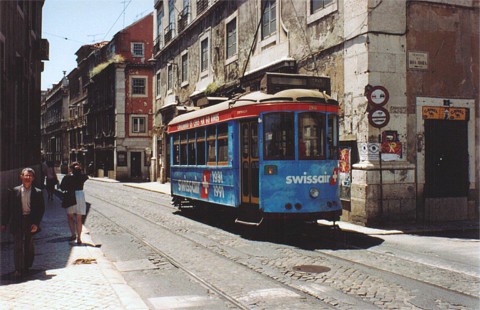 These 84 trams were constructed with the use of
the trucks and electric equipments of older series: all
except one of the open 4-wheel cars, four São
Luís cars and one Brill. The numbers of the original
trams were retained. The 203-220 were converted in the early
sixties to single end cars and allways used in combination
with trailers. The bodies of 39 of these cars were used for
the construction of Carros Remodelados series 541-585.
These 84 trams were constructed with the use of
the trucks and electric equipments of older series: all
except one of the open 4-wheel cars, four São
Luís cars and one Brill. The numbers of the original
trams were retained. The 203-220 were converted in the early
sixties to single end cars and allways used in combination
with trailers. The bodies of 39 of these cars were used for
the construction of Carros Remodelados series 541-585.Series 613-617, 701-735
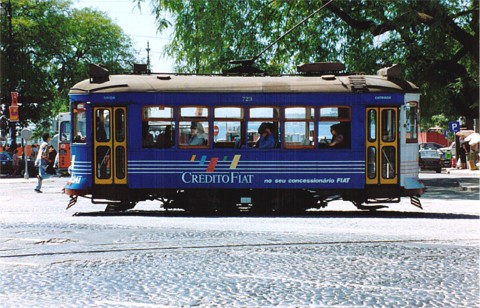 These 40 trams were complete new constructed.
They were always used on the routes with the most steep
inclines and equiped with six independent brake systems.
Part of the series (713, 717, 720, 732, 733 & 735) is
still available for service. The 726 & 723 did become
the Tourist service cars 3 & 4. 722 is used as
"Christmas tram". 712 went to A Coruña. The bodies of
six cars were used for the construction of Carros
Remodelados series 541-585.
These 40 trams were complete new constructed.
They were always used on the routes with the most steep
inclines and equiped with six independent brake systems.
Part of the series (713, 717, 720, 732, 733 & 735) is
still available for service. The 726 & 723 did become
the Tourist service cars 3 & 4. 722 is used as
"Christmas tram". 712 went to A Coruña. The bodies of
six cars were used for the construction of Carros
Remodelados series 541-585.
Series 761-763, 771-785
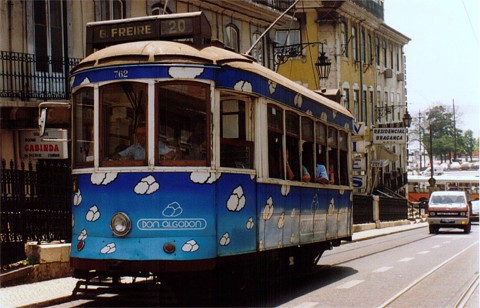 These 18 single end trams were reconstructed
out of older tramcars. Like the series 613-617 & 701-735
they were fully equiped for the hilly tramroutes. In the
next table is an overview given of the trams used for the
reconstruction of this series.
These 18 single end trams were reconstructed
out of older tramcars. Like the series 613-617 & 701-735
they were fully equiped for the hilly tramroutes. In the
next table is an overview given of the trams used for the
reconstruction of this series.| car |
body |
truck |
car | original | car | original | car | original | car | original | car | original | |||||
| 761 |
276 |
736 |
771 |
557 |
774 |
563 |
777 |
566 |
780 |
565 |
783 |
564 |
|||||
| 762 |
226 |
739 |
772 |
554 |
775 |
553 |
778 |
571 |
781 |
567 |
784 |
559 |
|||||
| 763 |
568 |
740 |
773 |
561 |
776 |
562 |
779 |
555 |
782 |
560 |
785 |
556 |
Series 737, 738, 741-745
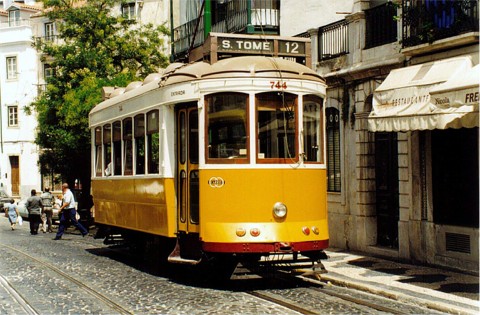 These seven double end trams were reconstructed
out of older tramcars. Technical they are equal to the
single end cars of the series 761-763 & 771-785. Trucks
and electric equipment did originate from the Caixote series
736-745 with retaining of the numbers, while the bodies did
come from the series 200. Some of these cars (741, 742 &
744) are still available for service. 745 is used as
"Christmas tram". 743 went to A Coruña.
These seven double end trams were reconstructed
out of older tramcars. Technical they are equal to the
single end cars of the series 761-763 & 771-785. Trucks
and electric equipment did originate from the Caixote series
736-745 with retaining of the numbers, while the bodies did
come from the series 200. Some of these cars (741, 742 &
744) are still available for service. 745 is used as
"Christmas tram". 743 went to A Coruña.
Remodelados series 541-585
These 45 tramcars were constructed with the use of old
bodies originating from the 200 and 700 series, and new
constructed trucks and electric equipments. They are working
on all lines and equiped with pantographs as well as trolley
poles. Although they have doors at the left side, they are
fully single end cars. Six cars are in use for the tourist
service with the numbers 5-9 & 11. In the next table is
an overview given of the trams used for the reconstruction
of this series.| car |
body | CT |
car |
body | car |
body | car |
body | CT |
car |
body |
CT |
||
| 541 |
270 |
550 |
278 |
559 |
222 |
568 |
254 |
577 |
252 |
|||||
| 542 |
241 |
551 |
235 |
560 |
238 |
569 |
257 |
11 |
578 |
225 |
||||
| 543 |
230 |
552 |
242 |
561 |
483 |
570 |
244 |
9 |
579 |
702 |
||||
| 544 |
236 |
553 |
237 |
562 |
275 |
571 |
223 |
580 |
262 |
|||||
| 545 |
277 |
554 |
264 |
563 |
261 |
572 |
255 |
581 |
724 |
|||||
| 546 |
227 |
7 |
555 |
246 |
564 |
266 |
573 |
272 |
582 |
701 |
||||
| 547 |
273 |
556 |
256 |
565 |
245 |
574 |
247 |
583 |
714 |
5 |
||||
| 548 |
228 |
557 |
240 |
566 |
265 |
575 |
267 |
584 |
707 |
8 |
||||
| 549 |
221 |
558 |
243 |
567 |
281 |
576 |
415 |
585 |
719 |
6 |
Bogie trams
Series 801-810
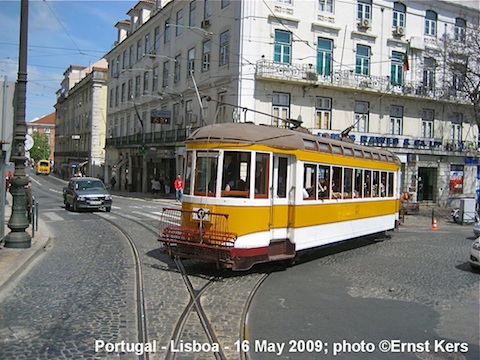 Just before World War II Carris did order 20
bogies for the construction of 10 new motorcars. These trams
had large platforms with sliding doors and seperate cabins
for the drivers. Due to the outbreak of the war, only half
of the bogies were delivered. For this reason only 5 of the
new tramcars could be put in service.
Just before World War II Carris did order 20
bogies for the construction of 10 new motorcars. These trams
had large platforms with sliding doors and seperate cabins
for the drivers. Due to the outbreak of the war, only half
of the bogies were delivered. For this reason only 5 of the
new tramcars could be put in service.The other five tramcars were equiped in 1943 with existing bogies, probably originating from the Carros do Povo series 362-367. When the second half of the batch of the ordered bogies were received in 1947, these were used for a new type of tramcars.
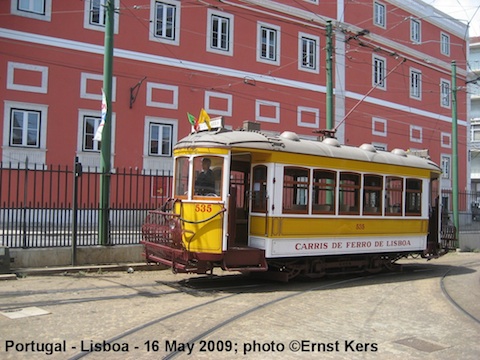 This was the
first batch of 20 complete new trams of the Standard
or Ligeiro 4-wheel type. They did differ from the
others as the height of the platform floors was
equal to those of the saloons. The disadvantage was
a larger height difference between street level and
platform.
This was the
first batch of 20 complete new trams of the Standard
or Ligeiro 4-wheel type. They did differ from the
others as the height of the platform floors was
equal to those of the saloons. The disadvantage was
a larger height difference between street level and
platform.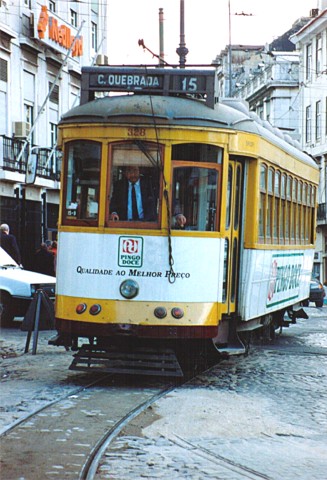 The trucks and
electric equipments
of these ten bogie trams were originating from one
car of
the series 283-322, five cars of the series 323-342
and four
cars of the series 343-362. The fleet numbers were
retained:
305, 327-329, 338, 340, 345, 353, 355 and 356. The
bodies
were new built in the "Standard" design. The 355 is
painted
red as tourist tram number 10 and in use as
information
office on Praça do Comercio.
The trucks and
electric equipments
of these ten bogie trams were originating from one
car of
the series 283-322, five cars of the series 323-342
and four
cars of the series 343-362. The fleet numbers were
retained:
305, 327-329, 338, 340, 345, 353, 355 and 356. The
bodies
were new built in the "Standard" design. The 355 is
painted
red as tourist tram number 10 and in use as
information
office on Praça do Comercio.